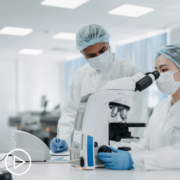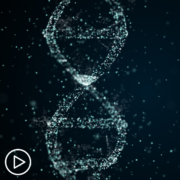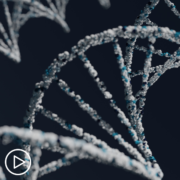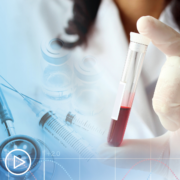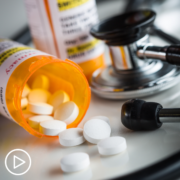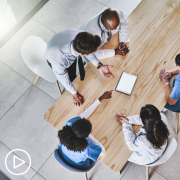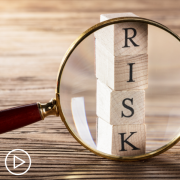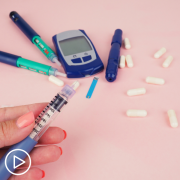Emerging Research and Promising AML Treatment Approaches from Patient Empowerment Network on Vimeo.
Downloadable Program Guide
Leading experts shared recent breakthroughs in AML treatment and research announced at the 2018 American Society of Hematology (ASH) annual meeting. The panel discusses new drug approvals, emerging clinical trial data, innovative, individualized approaches to treat distinct AML subtypes, and how these advances translate to the real world and impact AML patients.
Transcript:
Beth:
Hello, and welcome to today’s webinar. I’m Beth Probert. I am an MPN patient, was diagnosed a few years ago with polycythemia vera. Today’s webinar is where are we headed with the treatment of acute myeloid leukemia. What can patients look forward to for the coming year?
This is a Patient Empowerment Network program. And I’d like to thank our sponsors. As always, our sponsors have no editorial control over the content. Today, we’re going to talk about topics like recent breakthroughs in AML treatment and research announced at the 2018 American Society of Hematology ASH Annual Meeting. We’ll look at emerging clinical trials and how to access them, individualized approaches to treat distinct AML subtypes, and how will these advances translate for patients. You’ll also hear from AML patient Steve, as he shares his first-hand experience facing AML and how he’s doing now.
We will also answer viewer questions. And if you have a question, please keep in mind, we can’t get real specific with these questions, so try to keep them general, really geared more towards information and questions.
And we’d like you to send your questions throughout the program. We will try to answer all questions that come through. And if we can’t get to all of them, we will certainly address them through future webinars. Now, I’d love to introduce you to today’s guest. Our first guest is Dr. Naval Daver, associate professor, Department of Leukemia at the University of Texas MD Anderson Cancer Center. Welcome, Dr. Daver. I’m so glad you could join us today.
Naval Daver:
Hello. Thank you for having me. Glad to join.
Beth:
And our next guess is Leah Szumita. And Leah provides clinical trial support at the Leukemia and Lymphoma Society. So, Leah, thank you. I’m glad you can be here today.
Leah:
Thank you. I’m so happy to be here.
Beth:
And our next guess is our patient panelist, Steve Buechler, and he is an AML patient who has had a remarkable journey. Steve, welcome from Minnesota.
Steve:
Thank you. I’m happy to be here.
Beth:
Great. Well, Steve, we’d like to get started with you. I’d like for you to tell our viewers a little bit about your life with AML. And if you can include how did you get diagnosed, what was that like getting diagnosed, and how did you react, who is your support team, and just what you’ve been though. So, I’ll turn it over to you now.
Steve:
Well, at age 64, I was living what I thought was a normal, healthy life. I had no symptoms. My primary care physician had been monitoring my white blood cell count for a couple of years because it was borderline low but not too alarming. And then, in the spring of 2016, it began to drop more precipitously.
So, he recommended I see a hematologist, and I went to do that. And the hematologist said I should probably have a bone marrow biopsy. And so, I agreed to do that sort of to humor them because I didn’t feel sick. I didn’t have any symptoms. I didn’t have any idea anything was wrong. It was a memorable week. The biopsy was on a Monday. On Tuesday, I swam my normal 50 laps. I did some shopping. I ate dinner out. Wednesday morning, I played in a weekly poker game with some retired guys. So, life was normal, until that phone call that came Wednesday afternoon informing me I had acute myeloid leukemia, and I had to get to a hospital right away.
So, the next day, I checked into a hospital. The day after that, Friday, I started chemotherapy. So, in 48 hours, I went from feeling perfectly healthy to 24/7 chemotherapy drip. And they started me on this standard treatment that’s been use, I think, for a very long time called 7 + 3 Cytarabine and Daunorubicin to try to get the cancer into remission. And so, I spent a week on that medication.
And then, I waited for the inevitable drop in my white blood cell count and my immune system. I was going to be very vulnerable to various kinds of infections. And as predicted, I came down with colitis and an E coli infection, body rash, and a bunch of other stuff that they couldn’t even identify. But the infectious disease doctors stepped in and dealt with those issues one at a time. So, I ended up spending 5.5 weeks in the hospital for my counts to recover. But the good news was, one month after starting chemo, they did a bone marrow biopsy that found there was no residual leukemia. So, the first goal had been reached, at that point. I was in remission.
Adding to the story, of course, the first night I spent in the hospital, my wife was with me and left late in the evening to go home. And as she arrived home, she had a stabbing pain in her right leg. The next morning, she got up and could hardly get out of bed, called 9-1-1. They brought her to my hospital in an ambulance through the ER.
And it turned out she had a fractured femur. So, I was on one floor of the hospital in the chemo ward, and she was on another floor of the hospital awaiting subsequent surgery to repair her leg. And then, she went off to a transitional care unit for rehab. So, when I realized our house was going to be unoccupied for about a month, I started to write to our neighbors on email. And I found it was a really useful way to communicate. So, I ended up, over the many months that followed, adding maybe 60 people to that email list and sending over 60 emails out, over the course of a year and a half to keep people informed of what was going on.
I, subsequently realized, as I was writing for other people that I was really using that writing to make sense of my own experience. I struggled to figure out what was going on and how I could capture it and how I could explain to people. And it was useful to get their responses back, but it was useful for me. It was very therapeutic for me just to have that writing experience to make sense out of what was going on.
After 5.5 weeks, I got permission to leave. I went home for a while. But I was awaiting the genetic testing of my cancer to figure out what the next round of treatment would be. Because I think people know, with AML, there needs to be a second arm of the treatment. It can come back very fast and very ferociously. I was told that the genetic testing of my cancer would put me in either a low risk or a high-risk category for recurrence. And that would point towards either chemotherapy, if it was low risk, and stem cell transplant, if it was high risk.
When the results finally came in, they said, “Well, you’re kind of in an intermediate category.” So, the way forward was not as clear as I thought it might be. So, I talked to my initial oncologist. I did my own research. I, subsequently, went and talked to a transplant oncologist at the University of Minnesota Medical Center who sort of nudged me towards the transplant option. I went to the Mayo Clinic and got a second opinion. And all of the indications really were that I would be a good candidate for transplant. I had no comorbidity. I had no other health problems.
And everybody thought I should probably be able to withstand the conditioning fairly well. So, eventually, I came around to that decision to have a stem cell transplant. I had a brother who was a half match donor. But the folks at the BMT unit said we also have some good umbilical cord blood matches for you. And so, I was, again, faced with the decision about which way to go. But it turned out they had a study. Don’t they always have a study? I was randomly assigned to the cord blood donor option. So, my brother was off the hook.
And I ended up having a double cord blood stem cell transplant in October of 2016, about four or five months after I was initially diagnosed. That procedure went very smoothly. And within three weeks, a biopsy revealed that one of my cord donors was 99% engrafted, which is pretty early for a cord blood procedure. So, that was good news. I was able to go home, at that point, and begin a pretty long, extensive, and sometimes arduous process of recovery.
The first 100 days, they offered me to come back to clinic daily for the first month or so to get blood tests, to get platelets, to get red blood cell transfusions, whatever it is that you need to keep you healthy. It’s a pretty vulnerable time. One of the oncologists, at the transplant unit, described this whole procedure as, first, we bring you to the brink of death by killing off diseased immune system. And then, we try to bring you back again. Well, it worked, in my case, I’m happy to report. So, by early 2017, I was beginning to taper off my anti-rejection medication. That ended in April of that year.
And then, it was just a process of gradually getting more strength, getting better. And, in my case, very fortunately, I avoided any trace of graft versus host disease. So, that allowed me to have a pretty healthy recovery. One year after my transplant, of course, I had to go in and get my baby shots, my vaccinations and needles because my previous immune system had been obliterated. And they only gave me the dead vaccines, at that point, because they reasoned I couldn’t handle the live ones.
So, that happened at Year 2. And that was recently completed about two months ago. I got the rest of my vaccines. The other good part of the story is, although there was a 60 to 70% chance of graft versus host disease, I never had any trace of that. I’ve since become very active in talking with other patients as a volunteer, doing some writing, becoming involved in the cancer community. And I’ve come to appreciate really how fortunate my story was. I think the three big indicators were I got into remission on the first try. I’ve talked to a lot of patients who haven’t been able to do that.
My transplant engrafted within three weeks, which was a very solid, early result. And a lot of patients don’t have that kind of success. And I had no graft versus host disease. So, that’s about as good of a story as you can have with AML, as I understand it. So, obviously, I’m very grateful to have done that. And something like that gives me a lot of motivation to try and give something back. So, I’ve been participating in various ways in the cancer community.
Believe it or not, that’s the short version.
Beth:
Steve, you have a remarkable story. I just heard – we talked earlier, and just to keep hearing your story again is really just so noteworthy. And the three points you made, just having the early remission the first time with chemo is amazing. And early engraftment just within three weeks and no graft versus host disease. And your enthusiasm and wanting to give back and just with your writing. And we’ll talk a little bit later. I know that you have a book that’s coming out. So, your story is, for someone like me, amazing. But Dr. Daver, I’d like to turn to you, for a few moments, and tell me, is Steve’s story typical?
And what kind of feedback do you have on his journey?
Naval Daver:
So, Steve’s story is a very good outcome story. It’s not necessarily typical, as Steve mentioned. About 70 to 80% of our patients will go into remission with the first induction. So, it’s a high number, but it’s not 100%. And if you don’t go into remission with the first induction that is actually one of the very high risk or adverse features. It’s called primary refractory AML. And those patients usually do have a much harder time. The second thing is about 60% of patients will fall in what we call intermediate groups. So, we do do molecular and cytogenetics. And if we find that we have favorable molecular cytogenetic changes, then, those are considered to be good.
And we may not do transplant. On the other hand, if you have unfavorable cytogenetic molecular, then, it’s very clear a transplant probably is the only hope for long term survival. But, unfortunately, a lot of patients fall into intermediate group.
Now, that intermediate group is becoming smaller and smaller because we are understanding more and more about the molecular machinery, the cytogenetics, and the prognostic impact of new molecular mutations. So, we are able to triage patients better into high risk or low risk, which helps us make the transplant decision. But I think the most fortunate thing, in Steve’s case, was the lack of GVHD. And that actually is very uncommon. Most of the patients we see will have some degree of GVHD. It may be acute. It maybe chronic. In most cases, I will say that it is manageable. We rarely see very severe ICU requiring GVHD or fatalities from GVHD.
But about 60 to 70% will have some degree of GVHD, will require some treatment for it with steroids or additional immunosuppression. And in some cases, it can take many months and can be a major discomfort and affect quality of life. So, I think that was fantastic that he did not have the GVHD. And I think all of those features, although are seen in a traditional AML story, I think Steve was fortunate, and the outcome was very favorable so far.
Beth:
Great. I really like that feedback. And what I wanted to ask you, as well, in regard to the no graft versus host disease, you said about 60 to 70% will actually encounter that. So, am I correct in assuming then that, when you do a transplant with someone, you account that that’s probably going to happen, the graft versus host disease and you have treatments and things lined up in anticipation of that happening?
Dr. Daver:
Yeah, absolutely. When we do the stem cell transplant itself, we actually do prophylaxis for graft versus host disease. Almost all patients will be on steroids, some form of immune prophylaxis. It may be tacrolimus. It may be sirolimus. There are some newer drugs. And in spite of that, if we see graft versus host disease, we have some very good medications.
In fact, some recent drugs approved such as Ruxolitinib, Ibrutinib, etc., which can work. But in spite of all of that, I would say a majority of patients do face a struggle with graft versus host disease. And they do have some degree. Now, again, it may not be severe. It may be in the form of graft versus host disease of the mouth, which causes your ability to eat to be decreased, or it may be the skin, which may be itchy or uncomfortable, or it could be ocular, which causes eye irritation and burning and requires eye drops. So, they may not be severe, but they hugely do cause discomfort of that quality of life.
But yes, we do try our best to avoid it. And in some patients, we are able to get away with none. And in some patients, they will have mild to moderate, which has to be treated. Luckily, with the newer generation of immune prophylaxis monitoring treatment, we have very few severe graft versus host disease, which is a good thing.
Beth:
Great. I’m so glad you touched on that. So, I wanted to shift gears a little bit, Dr. Daver, and find out from you what are some of the key takeaways for AML patients and care partners from ASH.
And I also wanted to say what I’ve heard a lot, in regard to AML is that, for almost 40 years, there was just a standard way of treating. And all of a sudden, in the very recent years or maybe year, I’m hearing that there’s so much now, new drugs and things happening. So, would you mind touching upon some of those key takeaways?
Dr. Daver:
Absolutely. I think, this year 2018 was clearly the year of AML. There’s just, compared to all of the other malignancies, in the last two years, there’s just been a huge amount of progress in the way of approvals. Now, what I do have to say is, although we are seeing the fruits of a lot of efforts, actually, the research in AML has been very intensive for the last 15 to 20 years. And what we’re now seeing is really the combination of a lot of those efforts. Molecular, immune analysis, which have led to these drug approvals.
But today, really, I think, compared to even three years ago, when we did not have a number of these drugs, the whole outlook for treatment of AML has changed dramatically. So, we’ve had eight new drugs approved in a few years. And, to put it in perspective, for the 40 years before that, we actually really had almost no drug approved. There was one drug, Gemtuzumab, approved, but it was actually withdrawn from the market. So, when they say when it rains, it pours, that kind of really did happen, in the case of acute myeloid leukemia. But what’s really important, I think, I that there are now a number of targeted therapies towards particular mutations.
And some of these have actually been approved, in the frontline setting. So, now, it has become very important that we don’t just treat all AMLs as one disease. In fact, that’s something we knew for about 20 years that AML is one of the most heterogenous of all malignancies. Lung cancer and AML, these are probably the two most heterogenous cancers where it’s not really this is AML, it’s different types of AML, which can have prognosis of 95% cure rate all the way down to 10 to 15%.
So, identifying these groups was very important for prognosis. And that’s something we have been doing but more important for treatment. So, for example, a mutation that is called an FLT3 mutation is very, very important because, on its own, it is associated with an adverse prognosis. These patients had high white counts, proliferative disease, and their three year or five-year survival was usually 20 to 25%, when we first identified this mutation in 2001. Now, there are new drugs called FLT3 inhibitors that specifically inhibit the FLT3 mutation pathway.
And with the addition of FLT3 inhibitors, specifically a drug called Midostaurin that was FDA approved 1.5 years ago, plus stem cell transplant, and even more so, at the recent ASH 2018 meeting doing post stem cell transplant, FLT3 inhibitor, when we do all of these three interventions, we’re now getting up to five year plus survival rates of 75%. So, this is amazing.
The patient who was 25% 12 years or 13 years ago, when we first identified this mutation, could today, if appropriately treated with FLT3 inhibitor transplant and FLT3 inhibitor maintenance, could be in a 75% long term survivor rate. So, tripling those outcomes. And similar things are being seen for other groups. For example, APL, acute promyelocytic leukemia, is one disease where we actually are able to treat these patients without chemotherapy. So, you can give a combination of ATRA arsenic, which gives you 95% cure rates.
So, the key now, and what I tell a lot of our community doctors, our fellows, other academicians is it’s not about just rushing in treatment, which has been the paradigm for 30 or 40 years, but more important, it identifies specific molecular mutations or cytogenetic changes and choose the best treatment because the impact of choosing the appropriate molecular or non-chemotherapy or antibody based treatment is, actually, much more than quick therapy. And I think that message now is going out.
And things are improving overall.
Beth:
Wow. And what I’m hearing are two things. Eight new drugs, however, those eight drugs are specifically going to be used, in regards to different mutations. And so, my question to you is it’s very obvious that genetic testing, for these mutations, is a huge puzzle piece to this. And could you talk a little bit about that. At what point can a patient get this genetic testing from the mutations. And if you could just speak to that because it just sounds that is essential?
Dr. Daver:
Yeah, absolutely. I think that is probably the No. 1 takeaway for both patients, caregivers, and physicians. So, the genetic testing should be done for all new AMLs at the time of diagnosis. And there are a number of different labs across the country, commercial labs, that are able to do this new genomics, foundations, hematologic, all of these are not insurance approved and covered.
Some of the larger academic centers have their own molecular testing analysis. The most important thing is that we should usually wait for these results before rushing into therapy. And just to give an example, when we see a new AML at MD Anderson, we will rush their cytogenetics and molecular testing. We’re looking for cytogenetics to rule in or rule out APL, acute promyelocytic leukemia because this can be treated without chemotherapy with 95% cure rates. The other big group we’re looking at is what we call core binding factor leukemia. These are a group of specific chromosomes associated leukemias.
And if you find those, then, that is the group or the addition of the antibody treatment called Gemtuzumab Ozogamicin or Mylotarg, which is FDA approved, can improve the survival rates by almost 20%, which is a huge amount on top of chemo. So, you don’t want to miss identifying this core binding factor of chromosomes. Then, if we don’t find one of these two, then, we rush our molecular panel.
We are fortunate. We get the molecular results in 48 hours. That’s one of the places in the country. There are a few other groups that are in the same range. But even in the commercial setting, I know for a fact that they’re able to get these results in six to seven days. So, I think it is actually possible and feasible. And even on some of the large trials we’ve done across 100 plus centers, we were able to safely wait for those results. Two molecular results were most important looking for our FLT3, if you find that mutation. We want to add the FLT3 inhibitor up front, and then, IDH1, IDH2 mutation.
And if you find those, we may consider, on a trial basis, adding IDH1, IDH2 mutations. And then, if none of those mutations or chromosome groups are identified, then, we will consider standard treatment. But even there, we have trials where we’re adding new drugs, which have shown very high activity like Venetoclax or Nivolumab or immune therapies to standard chemo. So, really, this is now personalized therapy. There are five clear subsets of AML that will have different treatment approaches.
And addition of the appropriate agent could improve your survival and cure rates from anywhere from 10 to 30 or 40%. So, I think this is quite important.
Beth:
It’s just amazing. And what I’m also picking up on, and what I’ve been told about AML, is that you need to move quick. This is, once diagnosed, time is of the essence, and especially with the different subtypes. So, we’re talking about genetic testing. And I really, really was very interested in hearing how it works and how quick it could be turned around. But what would you say – we very often hear, like in Steve’s case, it was his doctor who referred him to a local hematologist and then, eventually, to a specialist? Sometimes, we hear people being rushed to the hospital or going to their local doctor. But time is of the essence, in getting this genetic testing.
What advice do you give patients who, typically, might go to a local doctor, how to move along in this process and how to advocate for that genetic testing? Do you have any feedback on that?
Dr. Daver:
Yeah. I think there’s a fine balance. And that’s where it’s hard to make a generalized recommendation across the board because there are some AML patients who come to us who have a very high white count, more than 100,000, for example. They may have evidence of leukemia already infiltrating their liver or kidney, with organ abnormalities and lab changes. And in those patients, we may have to start treatment very early. But those are the minority. We’ve published, as other groups have looked at this, those make up about 5 to 10%. So, in the majority, it is, actually, a mindset change.
And this is something we’re doing a lot of education on, as well, is that that mindset of the sun should never set on AML. We have to treat right away, actually, was true, when you didn’t have other effective therapies that could be added that could change your outcome from 25% to 75%.
But today, in fact, I think it’s much more important to select the appropriate treatment or the addition of the appropriate molecular immune therapy than rushing into treatment. In fact, our group, as well as a number of other groups in the country, have published it. So, what we recommend, in general, is we get a new AML. We would admit those patients. I still think this is an inpatient disease. We would monitor them closely. We send, on the same day that we see them, a molecular chromosome panel. We ask it to be rushed. And then, usually, we can get these results in three to five days.
And I would wait to get those results because, based on those results, we may choose a FLT3 inhibitor. We may choose the antibody Gemtuzumab. We may choose IDH therapy. We may choose ATRA arsenic. So, I think, for most patients, what you could do, of course, you have to be careful when you’re discussing it with a physician, you don’t want to push on them too much. But I think it’s important to ask about molecular therapies, molecular trials, whether we could get the molecular information early, and how we could incorporate that.
I think, the good thing is we’re seeing, across the country, most of the physicians are taking this approach. And there is very intense education. But I still think it doesn’t hurt to ask about it and make sure that that testing is being done because I think it could make a huge difference in your outcome.
Beth:
Great. Wonderful feedback. Now, Leah Szumita, I’d like to bring you in on this conversation because we heard eight new medicines right now. That’s huge. And as Dr. Daver said, those are the results of clinical trials. And, recently, I heard that only about five to eight percent of adult cancer patients are participating nationwide, in the United States, in clinical trials. That seems like such a small number. And we depend on these patients to participate in these clinical trials to come out with these eight new meds.
There’s definitely a gap. And I’d like to hear your feedback about just that. And then, if you can go into – I’m going to ask you a few more questions about how people get involved in clinical trials. So, take us through that.
Leah:
Great, I will. So, I have to echo Dr. Daver’s sentiments about the importance of the genomic testing as well. And really, the new breakthrough in AML therapy is just a testament to the ongoing research. As he said, the research has been happening for 15 or 20 years. And we’re finally seeing the fruits of the labor. So, it’s encouraging. And that five to eight percent is low, but there’s room for improvement. And I think many different organizations have identified barriers to why these enrollment rates are so low. I will say that, of all of the clinical trials, somewhere between two and ten percent of clinical trials have to close because of low accrual rate.
So, there is just serious work to be done. I think, you can look at barriers in two different ways. There are patient barriers. There’s just a lack of awareness that clinical trials exist for all stages of diseases. So, many people believe that a clinical trial is only for those who have exhausted all other treatment options. And so, that’s actually not true. There are trials for every stage of disease. Previously untreated, newly diagnosed, relapse refractory, maintenance and remission. There are other barriers that people are afraid to be a guinea pig.
And so, I think, as healthcare providers, that’s our job to really educate that clinical trials are very controlled, closely monitored situations, provide education on the different phases and what those mean. There are very complex and stringent inclusion/exclusion criteria to clinical trials, which, in one way, can make it very difficult to understand, if you’re even eligible for a trial.
And so, that’s why clinical trial nurse navigators, such as myself, can really help patients and caregivers sort through that information. And then, sometimes, physicians aren’t aware of all of the trials that are out there either. And that is not to slight practitioners, but, again, it’s just an overwhelming amount of information. It takes time to stay on top of all of this research. It takes time to go through all of this research and all of the different protocols.
And so, it’s really important for patients and caregivers to have an advocate to try to identify what clinical trial is right for them.
Beth:
And so, through the Leukemia and Lymphoma Society, you offer this service, if I understand you correctly. So, patients and their caregivers can reach out to your department and find out what is there for me. What comes to mind, also, I hear quite often, and we’ll get Dr. Daver’s opinion on this as well, in just a moment, but there seems to be roadblocks to people, not only I don’t want to be a guinea pig and understanding that piece of it, but also are there some financial hurdles, geographic hurdles?
I hear from patients, quite often, that I live so remotely. I’m in a rural area. How would I manage this? So, could you give a little feedback about that?
Leah:
Sure. First, with regards to the financial barriers, another common myth is that a clinical trial is free. And, unfortunately, it’s not. I would say that, often times, whatever is being studied, either a new drug or a combination of drugs that usually is covered by the sponsor of the trial. But the rest of the care needs to be billed to insurance. And then, there’s this third bucket of cost, which is the money it takes to get someone and their family members to and from all of these appointments, prolonged hospital stays away from home. So, those are significant financial barriers to participate, in a clinical trial.
There are resources out there to help navigate through some of these obstacles. And, again, I would encourage people to contact Leukemia and Lymphoma Society. We can help steer you to those resources. With regards to the geographic barrier, it’s correct. A lot of these large, academic medical centers are not in proximity to people in rural areas. And that is one key point of clinical trials that needs to be improved upon. And I think a great goal would be to get some of these later stage, later phase trials out into the community setting where they may not require quite as intensive monitoring.
But it can also be available to more patients and really diversify the patient populations.
Beth:
Great. Really great feedback. And then, Dr. Daver, I know that your center is very proactive with communicating clinical trials to patients. And could you just speak about that a little bit?
I know it must be overwhelming. You’re doing your research. You’re a clinician working with your patients and to keep on top of every clinical trial. But, again, I know that that’s something you’re very, very on top of. But could you give a little feedback about how you approach that?
Dr. Daver:
Yeah. As an AML expert, I would still say I’m not really aware of every AML trial, in the country. It’s not possible. There’s 200 or 300. And they keep changing every week. So, nobody really, at a clinician level, is going to be completely aware. Now, what we do know is the comorbid areas, the targeted groups, the particular mutational groups of trial, the new trials, and, of course, what’s looking more exciting, whether it’s in Phase 1, Phase 2, or Phase 3 development. I completely echo the sentiments. I think 100% of our efforts should be to get patients on trial. And, at MD Anderson, we have 180 trials in leukemia alone of which about 70 or 80 are in AML.
And, of course, this is on the higher end of the spectrum. But the focus is really to enroll people on trial. And, I think, what patients often, and I hear this almost every day in clinic, is that they’re concerned because, when you say a trial, they are thinking experimentation. I think there’s a big difference in experimentation and clinical investigation. So, our effort is always to offer trials that give you standard of therapy plus something. And, in fact, whenever we’re treating a frontline patient, no leukemia expert, least of all, in a very large academic center, is going to randomize the patient to something other than standard of care.
But what we do want to see is can we improve the standard of care. And that’s how all of these new drugs go approved. So, we were doing these trials with FLT3 inhibitors added to chemotherapy for almost 10 or 11 years at some of the large centers in the country. Similarly, with IDH inhibitors or Gemtuzumab. And I have many patients who, seven, eight, nine years ago, were able to go on these trials, many, many years before the FLT3 inhibitors approved and get those benefits.
So, the way we like to put it is to try to get you tomorrow’s therapy today. So, you’re going to get access, approximately, four to five years before a drug is approved. And almost always, you will get the standard treatment plus something. So, you’re not going to get less. You’re going to get more. Now, of course, all of the additions may not work. But the chance is that at least you’ll get the benefit of standard agent plus something. And a lot of times, when we explain that, then, patients, of course, say I would like the trial rather than just standard of care.
The other thing is, with the cost, although it’s true that the drugs may not all be free, at least you may get some or part of, in some cases, all of the drugs free. So, at least there is some incentive there because, a lot of times, people say the insurance covers it. But the cost of a lot of drugs is astronomical. And even if you’re paying just 5% for an average AML drug targeted therapy, which is somewhere between $15,000.00 to $20,000.00, that 5% can be $1,000.00 to $1,500.00 a month.
So, a lot of times, what I see from my patients is, when they go on our trial for FLT3 inhibitors and IDH inhibitors, and even the fact that they’re not paying their co-pay, often offsets their cost of coming to MD Anderson or coming to Dana Farber or Sloan Kettering or whatever it may be. So, I really think that one should definitely talk to the Leukemia and Lymphoma Society, other major organizations, so that they can find out what trials are there. And many times, patients say, well, don’t think there’s a trial for me, or their local physician may not be aware.
And I can guarantee you, almost 99 to 100% of the time, there will be not just one but many, many trials that are available to you. So, I think that little bit of effort, emails, phone calls can go a long way.
Beth:
Great feedback. And Leah, going back to you, excuse me – I’m sorry. I just need to stand up a moment. I’m in a room that decided the lights would go off. But you can all hear me. Speaking to you, and I’m getting towards our lights, can you talk about what questions someone can ask their doctor, in regard to clinical trials?
What are those important questions?
Leah:
Absolutely. So, there are so many of them. And one of the things that my group of nurses and myself do is really provide people with education about the basics of clinical trials and then, the language and the questions they can use, when they go back to their provider. And then, also, when they go to make that connection with the clinical trial group. So, the list is long. I would say first and foremost, asking what the risks and benefits are. Many times, in a clinical trial, there are different requirements about how often someone might come to and from the site, what the finances might be related to that.
Also, a lot of studies or drugs used in studies have been used in other studies. So, asking if there are any early results or any results from prior studies using those medications is important.
And asking about how this may affect quality of life, all of those different kinds of questions. There’s a very long list. We do have a fabulous clinical trials booklet that patients and caregivers can obtain that have lists of questions. And we always encourage people to read through that material as well. But knowledge is power. So, the more knowledge and research someone does, and bringing someone with them to these appointments to really take notes because it can be so difficult to absorb all of this information, would be some of my recommendations.
Beth:
Wonderful. Great feedback. So, Steve, I’d like to circle back to you now. You have this overwhelming, very intense journey. Where did you get information about AML? Where did you get support? We hear that so often, when someone is diagnosed, and they have to handle and make decisions fast, what kind of resources did you utilize. And tell our viewers out there, so the can understand what to do and how to do it.
Steve:
Well, one thing I did not do is go on the internet and scare myself half to death. I trusted my doctors. It did happen so quickly that I was in treatment before I even understood the nature of my disease. So, for better or worse, I was getting on that train and going wherever it was going to take me. But I had a great team of social workers. I had great nurses. My oncologist was excellent in spending as much time with me as I wanted. And so, it was a gradual kind of learning curve for me. And the fact that the early treatment went pretty well, obviously, helped give me confidence.
And the same thing, when I went down to the University of Minnesota Medical Center. They gave me a very thorough explanation of what was going on, recommended the stem cell transplant. I had a colleague whose father actually worked in this area decades ago.
And I talked with him. He stressed the importance of getting a second opinion. So, I was able to go to the Mayo Clinic, which is about an hour and a half drive from where I live. And I talked, first, to a hematologist who said I can tell you some things, but you should come back and talk to the transplant experts here. So, I did that as well. So, between my initial oncologist, my transplant oncologist, my second opinions at the Mayo Clinic, I was pretty confident that not that it would all work out, but this was the best path to follow. And as I followed that path, I did get invited to a clinical trial.
Just from a patient’s perspective, some years ago, I was the caregiver for my mother, as she was struggling and eventually dying of breast cancer. And her oncologist wanted to put her in a clinical trial. And I was very suspicious, and wondering is she not going to get the kind of care that she needs because you want to use her as a subject in a study. And I declined that study. And some years later, I find myself being invited to join a study. And I asked a lot of questions, especially when I saw that 22-page consent form.
That’s pretty daunting. There’s a lot there, and there’s a lot to ask about, and I did. And people patiently answered my questions. And I just came to realize, essentially, in my case, the trial wasn’t even close to experimental. What they were saying is this is how we’re going to treat you regardless. But if you’re willing to do the study, we’re going to track the results. And that can help people down the line. So, at that point, it seemed almost like a no brainer. And I could have chosen my brother as a donor or a stem cell as a donor. Instead, I went into a study that randomized me. And I went into the stem cell, and it turned out just fine.
But they said the five-year survival rates for either path are about the same, so that’s why we’re doing the study to try to figure out what the different pathways are to that outcome and when something will benefit patients in the future. So, at that point, it just seemed like a reasonable thing to do. Helping people understand that you’re going to get the best treatment they can give you regardless, even though you’re in the study. I think that’s, for many patients, the key point. And it sounds like Leah and her folks are working on that angle.
That’s really important for patients.
Beth:
Wow, that is fabulous feedback. And if you could say – what I’m hearing you say is that you got a lot of support from, it sounds like, the hospital where you received your care. That there was you mentioned social worker, and they sounded like they were really there to give you support. Would you agree that everyone really worked together to help you through this journey?
Steve:
They did, both the professionals and circle of friends and colleagues. Of course, those email correspondences, as I said, I was getting multiple responses to every email that I sent out, from various people. Sometimes funny, sometimes dark humor, which I especially appreciate. Thank you, Dave, from Milwaukee. So, a variety of things that came in, people prayed for me. I’m not especially religious, but whatever they wanted to do was fine with me. So, the writing, again, was therapeutic.
I practiced a lot of mindfulness and meditation and yoga. I was a very active patient. I walked the halls five miles a day. When I couldn’t leave my room, I was on a treadmill. I just needed to do things that sort of kept my body up and moving. And I think that really helped my recovery. I had nurses tell me, at one point, I was doing better than any other patient, at that stage in treatment. I’m not bragging about it, but I think, again, initial good reactions made it easy to get in this upward spiral. I exercised, I ate as well as I could. And I’ve seen patients have a bad time. And they’re kind of in a downward spiral.
And it’s really hard to reverse that. If you don’t feel good enough to teat, if you don’t feel good enough to exercise, it’s really hard to get out of that box. And so, anything you can do or anything nurses or social workers can do to help patients be proactive, be as active as possible, ask lots of questions, in whatever fashion suits their needs. Try and tell your story, whether it’s Caring Bridge, or emails, or verbal recording of what’s going on, I think there’s a great therapy to just trying to put together, from a patient’s perspective, what the hell is going on here and what’s happening to me and how might it turn out.
And those are some of the things that helped me get through.
Beth:
That is just great feedback. And Dr. Daver, I’m picking up that Steve has just an amazing attitude. And what kind of feedback do you give about that? These patients, these wonderful people, their lives have been turned upside down. As you tell us, it’s just very quickly, they’re living one life and now another. How much do you see, listening to Steve’s attitude and trying to be proactive and advocate for himself, do you feel that’s an impact on overall success in treatment and moving forward?
Dr. Daver:
Yes, absolutely. I think that the attitude plays a major role. But I think a few things that Steve said are very important.
One is that he did seek out second opinions. He did go to Mayo Clinic, a very large academic center. He got additional input. He learned about clinical trials and outcomes. And a lot of times, we have patients who may contact us or physicians from outside who contact us or come to us. And sometimes, we may not have something different to offer. There may be a standard treatment. A lot of times, the peace of mind of knowing that you have consulted with a large academic center, one of the top centers, whether it’s Mayo or MD Anderson or Sloan Kettering, whichever it may be, often helps a lot.
And then, there may be other times when we actually do say, and this happens quite frequently, that, actually, we have a trial that I think will be a better FLT3 inhibitor or better IDH inhibitor or a better antibody. And this is what I would do, if I was in your place, or if I had a relative in your place. So, I think that helps your peace of mind and your mental framework. And the second thing is – and that’s not something we can control is how you do to the initial treatment.
If you have good responses, if you tolerate it well, then, of course, we do see that those patients are always more optimistic, have a better mental framework, it helps. But I also see that there are some patients who come in, with a very negative framework. And that’s where I think learning that there is so much new progress, that there are so many options, not only in the frontline setting, in the relapse setting, in the maintenance setting, even after post-transplant relapse. We have things that, potentially, could cure patients, which we didn’t have even five years ago.
So, I think knowing that there’s a huge amount of progress, that the cure rates have doubled, tripled, in some cases, in elderly AML and FLT3 AML. And no longer having AML is the end of the world. In fact, in our most recent data update that we are going to publish soon, we see that, in the young patient, 65 and below, the overall survival, if you gave all patients who visited MD Anderson is about 66%. So, 23 patients actually had a long-term cure.
And people are shocked, even physicians I know of in the ICU and ER settings, don’t realize this fact. In elderly AML, it’s tougher, but we are going from 10% to almost 45 or 50% cure rates in patients 65 plus. So, I think, once people hear these numbers, they completely change their mind and are much more optimistic. But getting that information across to patients, to caregivers, to make them do the referral or make them consider treatment, I think, is the first big hurdle that we have to kind of overcome.
Beth:
Wow. And that is just very right on target. So, I’d like to shift gears a little bit. We do have a few questions we have time for. And Dr. Daver, the first question I’d like to get your feedback on, and forgive me with the pronunciation of the actual medication, I’ll try my best. So, this question comes in, what is the role of Venetoclax, if any, in treating AML. And when might that be FDA approved, from what you might know about this?
Dr. Daver:
So, the Venetoclax is probably one of the most exciting drugs in AML, especially elderly AML. In elderly AML, it is the most exciting drug that we have had probably forever. So, we used to treat elderly AML, meaning above 65 years of age. And these are hugely people not just by age, but also based on the physician’s review who are considered not fit for intensive chemo. They may have kidney problems, liver disease, poor performance status, immobility. And so, we cannot give the high chemo, the 3 + 7 that Steve got. And we have to use lower intensity therapy.
And we used to use Azacytidine alone, with the response rate of about 20 to 25%- and 3-year survival of about 15 to 20%. And now, we’ve done a study using Azacytidine in combination with Venetoclax where the response rates were 73%. So, going from 25% to 73% not doubling or really tripling, and that the survival is now 46 or 48% going from 15 to 18%.
So, that’s a huge, dramatic shift, three times response rate, three times of the potential cure rates. So, I think, right now, we believe that Azacytidine and Venetoclax really should be the standard of care for elderly AML, if they’re not going to get induction chemo. And, in fact, it was FDA approved very recently. So, three weeks ago, in fact, right before the ASH meeting, end of November, Azacytidine in combination with Venetoclax, as well as low dose Cytarabine and combination with Venetoclax were FDA approved.
And I think, now, with the approval, although we were doing this even before the approval, no elderly AML patient should get Azacytidine or low dose Cytarabine alone. I really think addition of Venetoclax now is the standard of care, triple response rate, triple survival. There’s no reason not to do that.
Beth:
Wow. That is an amazing shift and such good news for our elderly patients. That is great. I do have another question. And I believe it’s targeted for you as well, Dr. Daver.
For those young folks, under 35, who relapse quickly, within about 100 days after MUD allo transplant for AML, M5, no mutation target, what will be a sustainable way to buy time and bridge for that next transplant. Could you talk a little bit about that?
Dr. Daver:
So, that’s a very tough scenario. Relapsing post-transplant itself is a very high-risk feature. It, basically, indicates that disease is aggressive and may not respond to further chemotherapy or transplant. But relapsing early post-transplant, which we usually consider within 100 or 120 days is actually quite an adverse feature. So, for those patients, I think the best chance is if we can find a targetable mutation. So, we will be looking for FLT3 or IDH1, IDH2 mutations. If we find those, then, I think we do have some chance with either a FLT3 inhibitor alone or, more likely, in a FLT3 inhibitor, in combination with low intensity therapy.
And there are a number of these agents either approved, but I would actually go for a trial where we’re combining either FLT3 inhibitors or IDH1, IDH2 inhibitors with other exciting agents like Azacytidine and Venetoclax. I think that will be the best shot of getting a long-term remission, potentially, a second transplant. Of course, there are a lot of caveats and variables. And you have to look at the individual patient to make that determination. The other group of therapies that you could use, if we don’t find the FLT3 or IDH because only about 30 to 40% of patients will have one of these three mutations, is immunotherapies.
And these can work really well, especially in the post-transplant relapse setting. And we have drugs such as antibody drug conjugates. These are antibodies that carry a toxin and can attack the leukemia cells. Or what we call immune check point antibodies. They’re also agents that activate your own immune system post-transplant to fight against tumor. And with these, we have seen some very exciting activity, specifically, in the post-transplant relapse.
And a lot of these are all under clinical trial setting because the antibodies and the immune checkpoints are not yet approved. They may be in the next couple of years. So, I think this would be an ideal scenario to find the academic center close to you and try to consider getting into one of the trials, either targeted therapy or immune therapy.
Beth:
And another question would be do you see post-transplant relapse more in specific mutations? Are those with specific subtypes of AML?
Dr. Daver:
Yes, we do. So, we see the post-transplant relapse most common in what we consider the adverse risk AML. So, the adverse risk AML are the patients we definitely take to transplant. But, unfortunately, even after transplant, they remain the group that have a high risk of relapse. So, these are patients who have what we call TP53, one of the worse mutations. They will often have a high risk of relapse post-transplant or chromosome changes like deletion 7, deletion 5, deletion 17, also another high-risk group.
And the third group is what we call secondary AML. So, there are two ways you could get AML. You could have spontaneous AML, most common. We have a patient, no prior history of chemo radiation, other cancers, who comes in with acute diagnosis of AML. But then, there’s another group making about 20 to 30% called secondary AML. So, these are people who have prior breast cancer, colon cancer, bladder cancer, and got either chemotherapy or radiation for that. Or people who had prior MDS, which is an AML precursor and then, developed AML.
And these people who have secondary AML are much more risky and also more prone to relapse post-transplant. There are a few new drugs like Vyxeos that can work well, in this situation. But, in general, these are probably the high risk molecular or morphological groups that could relapse post-transplant.
Beth:
Very interesting. Well, I so appreciate all of the wonderful information and feedback that our guests have provided today.
And the timing is great. Just coming off of ASH has been extremely encouraging, Dr. Daver, with you sharing all of these wonderful new eight new drugs and insight that’s going on. And, Leah, your feedback has just been phenomenal. And really, I believe it’s going to ease people’s concerns and fears about clinical trials, and between you and Dr. Daver speaking about the clinical trials, why they’re so essential, and they’re doable. And, Steve, your feedback, not only about clinical trials, but your journey is phenomenal. And I hope our viewers look forward to seeing information.
We may not have mentioned this. Steve has written a book soon to be published about his journey. He has some very interesting feedback that we just didn’t have enough time to share on today’s webinar.
So, thank you, again, to our guests and our sponsors. And a replay will be completed soon. And you’ll receive it via your email. So, our audience, please look forward to that. And remember, be your own advocate. Thank you.
We thank Celgene Corporation, Daiichi Sankyo, Genentech, Helsinn, and Novartis for their support.

